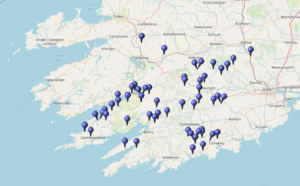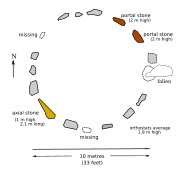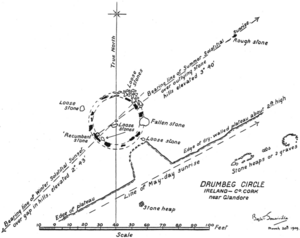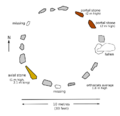Axial stone circle facts for kids

An axial stone circle is a special type of stone circle found in southwest Ireland, mainly in County Cork and County Kerry. These ancient rings of stones were built a very long time ago, during the Bronze Age.
What makes them special is how they are set up. They have an imaginary line, called an "axis," that usually runs from the northeast to the southwest. At the southwest end of this line, there's a flat stone lying down, called the axial stone. All the other stones in the circle stand upright.
On the opposite side of the circle, at the northeast end, there are two tall upright stones. These are often called portal stones because they look like an entrance or doorway into the circle. Axial stone circles always have an odd number of stones, like 5, 7, 9, or more.
Long ago, people thought these circles were like "recumbent stone circles" found in Scotland. But later, experts realized they were different. So, they were first called "Cork–Kerry stone circles" and then "axial stone circles."
One famous example is Drombeg stone circle. People have studied it a lot. It's said that if you stand there and look southwest along the axis, the sun sets right over the axial stone during midwinter. However, this special alignment isn't found at most other axial circles.
Contents
Where to Find Axial Stone Circles
There are many of these ancient stone circles in Cork and Kerry. In total, there are 56 circles with many stones and 56 circles with just five stones. You can see their locations on maps, like those from OpenStreetMap.
Ireland's National Monuments Service keeps a record of all important historical sites, including these stone circles. You can find lists of these sites, like the List of axial multiple-stone circles and the List of axial five-stone circles.
Understanding Their Design

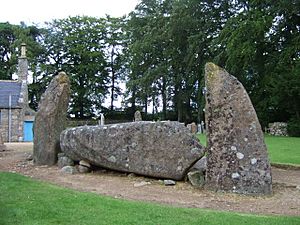
Early in the 1900s, a person named Somerville noticed that the Drombeg stone circle seemed to line up with the setting sun in winter. He thought it was like "recumbent stone circles" in Scotland. Both types have a stone lying flat and some taller upright stones.
However, there are important differences. In Scotland, the flat stone (called a "recumbent") is huge and heavy. The two tallest stones, called "flankers," stand right next to it. In Ireland, the flat stone (the "axial stone") is usually thinner and smaller. Also, the two tallest stones, the "portal stones," are on the opposite side of the circle, not next to the axial stone.
An expert named Ó Nualláin studied 88 of these circles in Ireland. He saw that they came in two main types based on the number of stones:
- Five-stone circles: These have exactly five stones.
- Multiple-stone circles: These have seven or more stones, sometimes up to nineteen. Most often, they have nine, eleven, or thirteen stones.
The multiple-stone circles are more similar to the Scottish ones.
Building These Ancient Circles
Axial stone circles were built during the middle to late Bronze Age, which was from about 1500 BC to 800 BC. The larger multiple-stone circles were likely built earlier in this period. To give you an idea, people started mining copper in Kerry even earlier, around 2400 BC. Other ancient tombs, like portal tombs and wedge tombs, were built even before that.
It's thought that the design of Irish axial circles might have come from the recumbent stone circles in northeast Scotland. The Scottish circles were built from about 2500 BC to 1000 BC.
Here are some things they have in common:
- One stone (the recumbent or axial stone) lies flat on the southwest side of the circle.
- An imaginary line through the center of the circle, going over this flat stone, points generally southwest.
- Sometimes, people found white Quartz pebbles scattered near or even under the stones.
- Small carved marks, called cup marks, are sometimes seen on the stones, often near the axial stone.
Scottish Recumbent Stone Circles
In Scotland, the two tallest upright stones (flankers) stand on either side of a very large, heavy recumbent stone. This stone can weigh as much as 30 to 40 tons! The other stones in the circle get shorter the further they are from the recumbent. Scottish circles can have any number of stones, usually between 9 and 18. They often have a small stone mound, called a ring cairn, in the middle.
The line over the recumbent stone points southwest. It seems that the builders chose locations where the horizon was far away, so nothing blocked the view. This might have been important for watching the moon or other sky events.
Irish Axial Stone Circles
In Irish axial circles, the two tallest upright stones are on the opposite side of the circle from the axial stone. These are the portal stones. The imaginary axial line passes right through the space between them. This space might have been seen as an entrance.
Axial stone circles always have an odd number of stones, from 5 to 19. This means there's always a clear space opposite the axial stone. The portal stones are usually the tallest, and the stones closest to the axial stone are shorter. The axial stone itself is usually a thin slab, set upright on its thin edge. The heaviest one found weighs about 4 tons. Even at Drombeg, the axial stone is only about 1 meter tall, 2.1 meters long, and 0.46 meters thick.
The axial stone points somewhere between south and west. But it doesn't seem to point to anything very specific in the sky. Sometimes, hills even block the view behind the axial stone.
Multiple-stone Circles
Multiple-stone circles in Ireland are similar in size to Scottish recumbent circles, though Scottish ones are generally larger. Irish circles are typically about 8.5 to 9.5 meters across. Some Irish circles have a stone in the very center, but Scottish ones do not. If there's a stone mound (cairn) connected to an Irish circle, it's usually outside the ring.
Archaeologists have dug up four of these circles: Bohonagh, Cashelkeelty, Reannascreena, and Drombeg. They found pits in the center with human bones that had been burned (cremated). There weren't many other objects, and it was hard to figure out their exact age from these finds.
Five-stone Circles
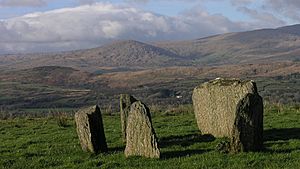
Five-stone circles are much smaller, sometimes only 2.5 meters across. They are often a bit oval-shaped, longer along the axis. The stones get shorter in height, from the tall portal stones down to the low axial stone.
These circles don't have a central stone or cairn. But often, there are other ancient stones nearby, like cairns or standing stones. Unlike the larger circles, five-stone circles tend to be found in groups, so you can often see one from another.
Two five-stone circles have been dug up: Cashelkeelty (which also has a multiple-stone circle) and Kealkill. Because these circles are so small, it would have been hard to use them for precise astronomical observations. While multiple-stone circles are often near the coast, five-stone circles are usually found on higher ground further inland.
When the Kealkill five-stone circle was first dug up, people thought the large stone on the north side was the axial stone. But now, experts believe it's a portal stone, and the actual axial stone is the smaller one on the southwest side.
The Meaning of the Axis

In 1906, an astronomer named Sir Norman Lockyer studied Stonehenge and suggested that the way stones were lined up might have something to do with the sky, like the sun or moon. He understood that when watching the sun rise or set, you need to think about where you are on Earth and how high the horizon is.
In 1909, Somerville applied this idea to Drombeg stone circle in County Cork. He was amazed by how similar it was to circles in Scotland, even though they were far apart. He found two main alignments at Drombeg:
- Looking southwest across the circle, over the axial stone, Somerville saw a clear notch in the hills. The sun set exactly in this notch during the midwinter solstice (the shortest day of the year).
- Looking from the axial stone, past a tall portal stone to another broken stone, he found a spot on a hill where the sun rose during the summer solstice (the longest day of the year).
Somerville looked at alignments from the center of the circle and also from the circle to distant natural features on the horizon.
Do They Point to the Stars?
It's hard to say for sure if most stone circles were built to point to specific things in the sky. There are so many stones and possible lines of sight. But for axial stone circles, because the axis is so clear, it's easier to study them as a group.
Some early studies suggested that about 12 out of 30 axial stone circles showed alignments with the sun or moon. This seemed like a meaningful result. However, later studies found mistakes in these calculations. When corrected, it turned out there was no strong link between the axes and specific sun or moon positions. They also found no strong link to stars.
The axial stones are long, so it would be hard to get a super-accurate line of sight just by looking over them. So, researchers have looked at the edges of the stone or its center point. Or they've used the stone to show a general area on the horizon where people might have looked for sky events.
More recent studies of the Scottish recumbent stone circles found that they often lined up generally northeast-southwest with the moon's rising and setting, especially during its "major or minor standstill" (when the moon reaches its highest or lowest points in the sky).
However, when these same researchers looked at the Irish axial stone circles, they found different results. The axes of the Irish circles generally do not point to specific hilltops or to particular times for the sun or moon to rise or set. Even at Drombeg, the famous midwinter sun alignment might just be a coincidence, according to later statistical analysis.
Experts now think that studying these alignments (called archaeoastronomy) helps us understand how ancient people thought about the world. It's unlikely these circles were early versions of modern observatories. While the axes of the circles are definitely not random – they almost all point between west and south – their exact purpose and meaning are still a bit of a mystery.
See Also
Images for kids


